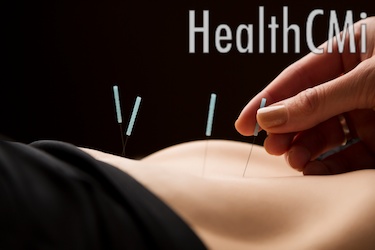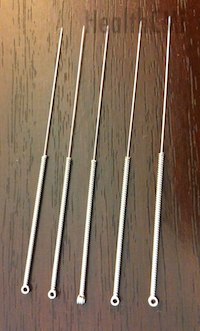Acupuncture and moxibustion successfully alleviate Crohn’s disease, an inflammatory bowel disease. Research published in the World Journal of Gastroenterology finds acupuncture combined with moxibustion effective in the treatment of Crohn’s disease. Subjective and objective findings confirm the results; both laboratory results and patient symptoms demonstrate significant improvements. 
Crohn’s disease, also known as regional enteritis, is an inflammatory disease of the intestines affecting the gastrointestinal tract from the mouth to the anus. Symptoms include abdominal bloating and pain, nausea, vomiting, mouth ulcers, weight loss, eye disorders, arthritis, fever, loss of appetite, chronic bloody or watery diarrhea, dermatological disorders, iron deficiency anemia and fatigue.
Crohn’s disease is considered an autoimmune system disorder. Genetics may play a role in its etiology; those with Scandinavian or Ashkenazim Jewish heritage have an increased risk of developing Crohn’s disease. Environmental factors may also contribute to this pathology. Smokers are twice as likely to develop Crohn’s disease than non-smokers. Other risk factors include low exposure to sunlight, obesity, diets high in sugar and saturated fat but low in fruits and vegetables, and urban living.
No biomedical cure exists for Crohn’s disease. Medical doctors use colonoscopies, sigmoidoscopies, capsule endoscopies, barium enemas and CT scans to confirm the diagnosis. Doctors focus on controlling symptoms by suggesting dietary and lifestyle changes plus pharmaceutical medications to suppress symptoms. The acupuncture and moxibustion research is hopeful in that it provides evidence that these treatment modalities are effective tools against the spread of Crohn’s disease.
Crohn’s disease differs from ulcerative colitis. Crohn’s disease commonly affects the colon, anus and the terminal ileum, the most distal aspect of the small intestine that connects to the cecum. Ulcerative colitis rarely affects the terminal ileum and anus but always affects the colon. Crohn’s disease causes patchy or serpiginous (snake-like) intestinal ulcerations whereas ulcerative colitis causes a continuous area of ulceration. Shallow ulcerations are typical with ulcerative colitis. Deep and penetrating ulcerations often occur with Crohn’s disease and may cause stenosis, a narrowing of the intestinal passage. Crohn’s disease may cause growth failure in children and increases the risk of cancer in the affected regions of the intestines.
The study was randomized, blinded and used control groups to rule out the placebo effect. Moxibustion was applied to acupuncture points Tianshu (ST25), Qihai (CV6) and Zhongwan (CV12) using the herb partitioned moxibustion technique. This is accomplished by placing an herbal cake on the acupuncture points and then igniting the mugwort (Ai Ye) moxa cones on top of the herbal cake.
The herbal cakes consisted primarily of the following herbs: Coptis chinensis, Radix Aconiti Lateralis, Cortex Cinnamomi, Radix Aucklandiae, Flos Carthami, Salvia miltiorrhiza, Angelica sinensis. The ingredients were then ground into a fine powder, sifted through a sieve and mixed with maltose and water to form a thick paste. A mold was used to form a 28 mm diameter cake of 5 mm thickness. Refined moxa was used and applied twice at each point on top of the herbal cakes.
Acupuncture needling was applied to Zusanli (ST36), Shangjuxu (ST37), Gongsun (SP4), Sanyinjiao (SP6), Taixi (KI3), and Taichong (LR3) to a depth of 20 - 30 mm. The needles ranged in length from 25 - 40 mm and the diameter was a consistent 0.30 mm. Manual acupuncture was applied to achieve a de qi sensation. Needle retention time was a total of 30 minutes. Acupuncture and moxibustion were applied three times per week for twelve weeks for a total of 36 treatment sessions. 
The total treatment efficacy rate for acupuncture combined with moxibustion was 83.72%. Histopathological scores significantly improved and symptoms significantly reduced. Acupuncture combined with moxibustion reduced anemia instances as reflecting in increased HGB levels. Bowel inflammation reduction was reflected in significant lowering of both CRP (C-reactive protein) and ESR (erythrocyte sedimentation rate) levels. The researchers note that the lab results indicate that “acupuncture effectively controls the inflammatory response and eases intestinal inflammation.”
The researchers concluded that “acupuncture provided significant therapeutic benefits in patients with active CD (Crohn’s disease) beyond the placebo effect and is therefore an effective and safe treatment for active CD.” Notably, lab scores along with quality of life scores improved. These findings are not isolated. Similar results were found in another body of research.
Researchers at the Shanghai University of Traditional Chinese Medicine and the Shanghai Research Institute of Acupuncture and Moxibustion measured the effects of acupuncture on basic fibroblast growth factor (bFGF) and type I collagen (Col I) in the intestines of laboratory rats with Crohn’s disease. After acupuncture, the expressions of Col I and bFGF reduced markedly in rats with Crohn’s disease. By reducing the abnormally high levels of Col I and bFGF, acupuncture prevents Chron’s disease related fibrosis of the intestines. Additional research finds acupuncture and moxibustion effective in reducing TNFa (tumor necrosis factor alpha), a substance linked to inflammatory bowel disease.
References:
Bao, Chun-Hui, Ji-Meng Zhao, Hui-Rong Liu, Yuan Lu, Yi-Fang Zhu, Yin Shi, Zhi-Jun Weng et al. "Randomized controlled trial: Moxibustion and acupuncture for the treatment of Crohn’s disease." World journal of gastroenterology: WJG 20, no. 31 (2014): 11000.
Shi, Zheng, Xiao-peng Ma, Huan-gan Wu, Xiu-di Qin, Qing-lan Qian, and Wei Zhang. "Effect of acupuncture-moxibustion on TNF-α, sTNFR-I and sTNFR-II of rats with Crohn’s disease." Journal of Acupuncture and Tuina Science 7 (2009): 29-32.
Chen Zhao, Juying Ding, Jindan Ma, Linying Tan, Huangan Wu, Yingying Zhang and Linshan Zhang, Acupuncture on the basic fibroblast growth factor and type I collagen in colons of rats with Crohn’s disease, JOURNAL OF ACUPUNCTURE AND TUINA SCIENCE, Volume 9, Number 1, 1-6.


